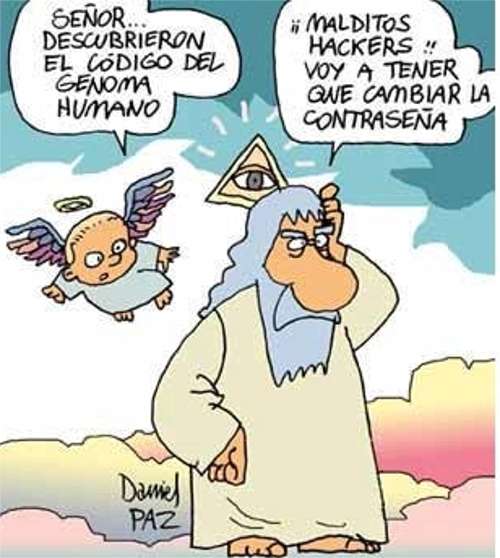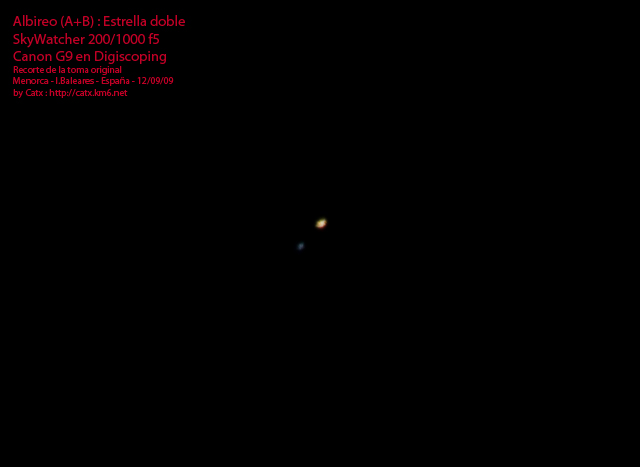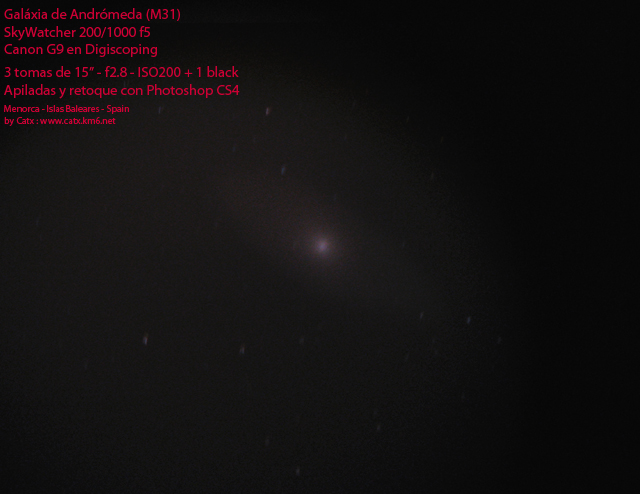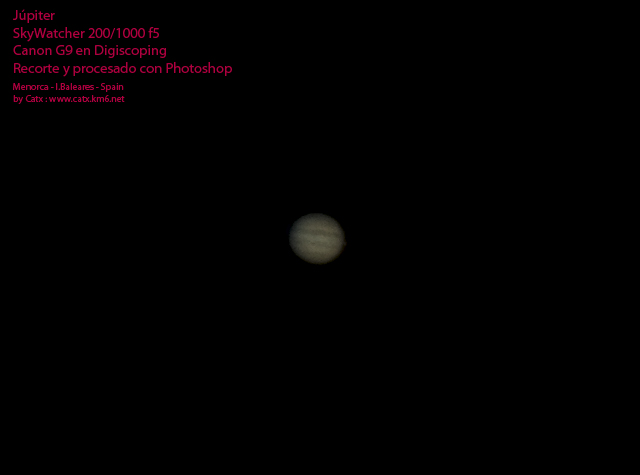Astronomical Journal: 12/09/2009 Well, after a few months with the telescope (Which spent nearly a month in service ...) and familiar with their operation through brief remarks, I finally make a night of watching "complete" doing a good look at one-thousandth of the marvels of the firmanento.
already did the replay "live" via Twitter (
modern q q I've gone ...;), so now recapitulate all a bit touched, processing the few (and painful
) photos I did and record in this new post in my blog, in Astronomical Journal
plan (sounds
jijiji q q nerd.) Here goes (and sorry for the lack of technical terms as I'm still
fish in this ...): - Astronomical observation: Date: 09/12/1909 (or rather ... night)
Location: Menorca (I. Baleares - Spain) 39 ° 48'00 "N 3 ° 70'00" E approx. (Google Maps
)
Visibility and conditions: On the outskirts of Mahon, acceptable light pollution but could be improved significantly, scattered clouds , northeast wind. Worst of all is that the smoke from the chimney of Gesa passes just above my position ...
Duration: from 23:00 to 2:30 (zzzZZzzz. .. zzzzzzzzzz
....) Once assembled all the equipment, a SkyWatcher 200/1000 on HEQ5 motorized mount (without goto) Starts the show; P
- Ring Nebula (M57): After locating and put in the search engine
star Vega (one of the brightest in the sky in the constellation of Lyra) sailing left
can find the Ring Nebula (Messier object 57) . After trying several eye, I'll take the 12mm, with which is small but with more detail than if "shot" of increases. You can clearly see the circular shape with the area faded somewhat dark interior (reminds me of a
Roman squid ... takes longer! jojojo ). The conditions will not let me see much detail.
is a planetary nebula
weak magnitude 9 + / -. We can see through that in their houses a white dwarf
.
unbeatable seafront Here is a picture from the wikipedia
:
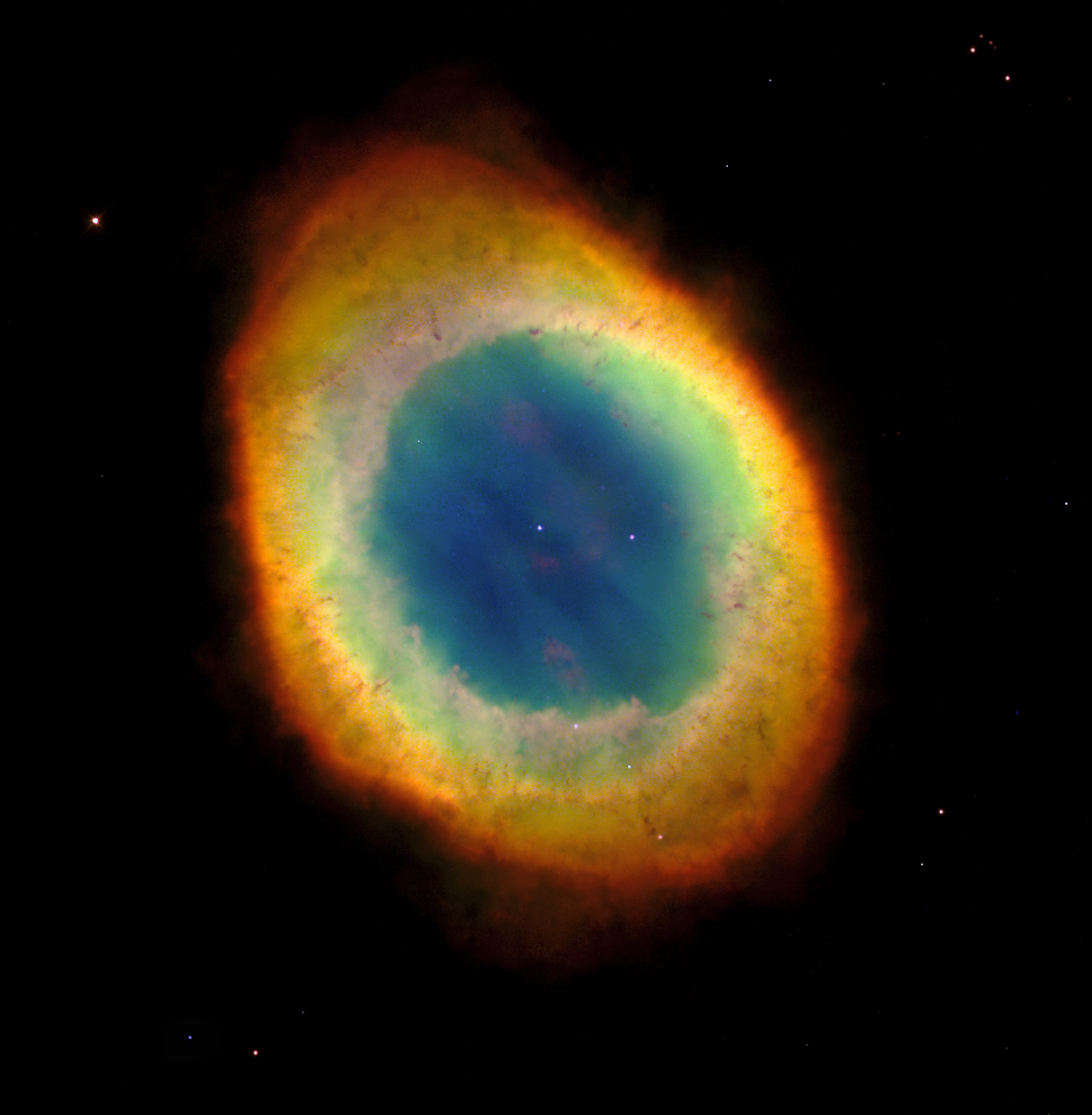 - Great Hercules Cluster (M13):
- Great Hercules Cluster (M13): is a globular cluster (mangitud 5.8) located in the Hercules Constellation
(next to Lyra). As its name suggests, is a large cluster of stars (
about 8,500! according to recent studies) that seen through the telescope you can get to see how all the dots are stacked on each other. This night I could not get to see much detail, but other observations at the home of a fellow (
Cicnus paix! ) if I could clearly see the stars completely defined.
A picture is worth ... so that here a picture from the wiki:
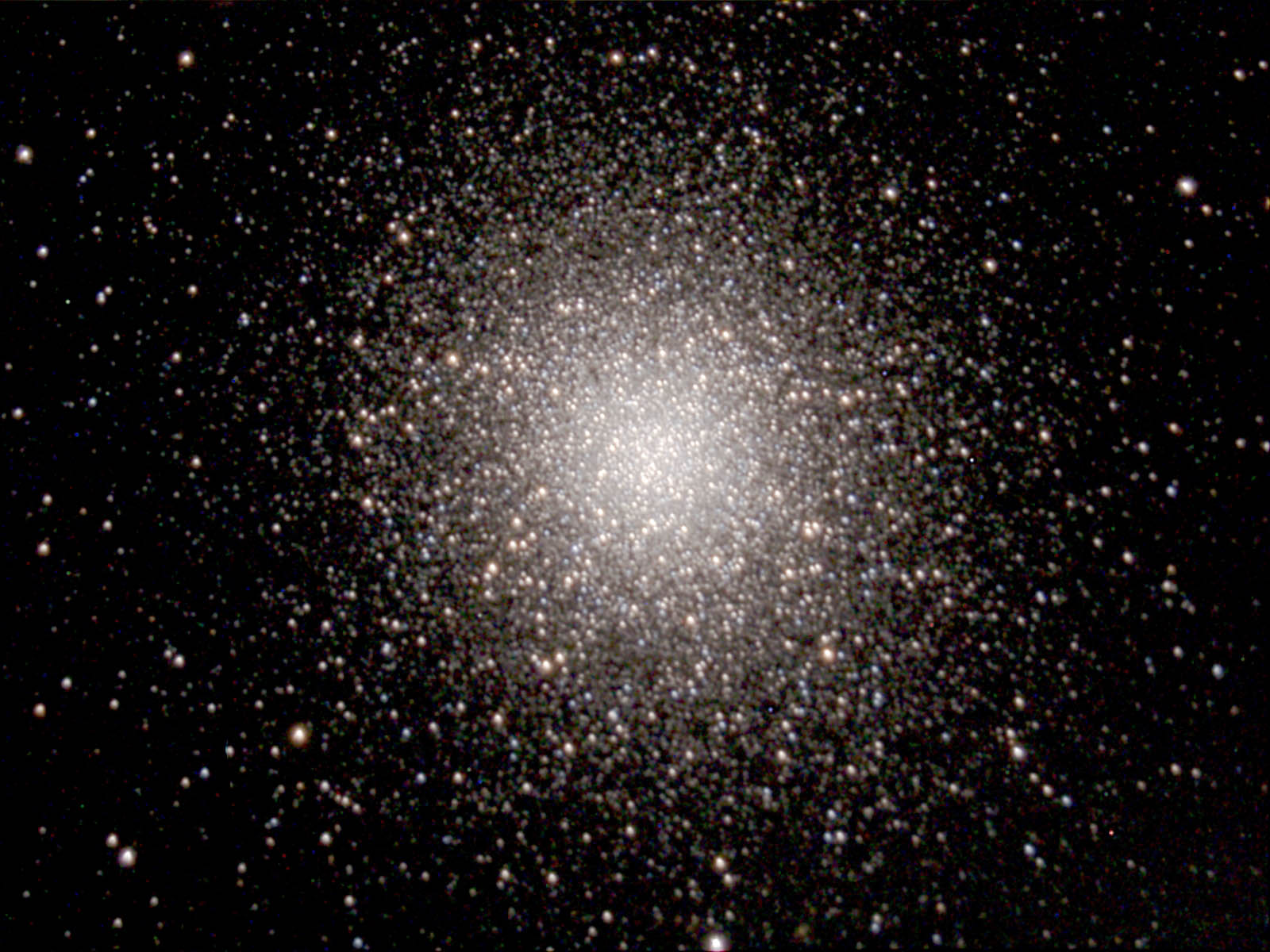
- Albireo (star twice): At first glance looks like a star, noted for its high gloss, but if we look to telescope (or plain binoculars) we see that it is a double star
of great magnitude. Is located at one end of the constellation of Cygnus
, and each star is identified as "A" and "B". What's special about this group of stars is their color. One is yellow while the other is blue, allowing you to have a very contrasted the two, hitting
the difference in color in "so close".
this if you "got" take a fotillo with my camera (a Canon G9
) attached on the eyepiece of the telescope using the technique called digiscoping
. No big deal but at least you will appreciate the difference color between the two:)
others had planned to observe deep sky objects such as
M16 or M20
, but was very low in the west, making it impossible for viewing by the light pollution. So I decided to decant for a safe observation, the Andromeda Galaxy.
- Andromeda Galaxy (M31): is the galaxy observed by beginners like me, because it is easy to locate and magnitude of 3.4 can be seen with modest equipment or binoculars. Actually the first day I noticed that I was very pleased,
was my first deep sky objects! ;)
identified as
Spiral Galaxy Messier 31 Object , which is part of
local group of galaxies (
with our Milky Way Galaxy and Triangle). It is the largest and brightest of the three, and
is located 2.5 million light years away . The most curious thing to read about it is that "
is approaching us at about 140 kilometers per second, and it is believed that between now and approximately 3,000 million to 5,000 million years would collide with ours and merge both form a giant elliptical galaxy . "Come on ... there are q rush or 3,000 million years we'll be all blind; P ...
a galaxy is so visible that the first reference we have is from 964, but it was not until 1612 that the first observation was made with a telescope. In 1764, Charles Messier
cataloged with the number 31 (M31).
is located in the constellation Andromeda
, direction of Cassiopeia
. It's easy to find as it only has to follow the three stars that extend from its neighboring constellation Andromeda to the shape of a W. Here a screenshot from the program Stellarium
your situation:
Once located I delighted watching it. Was clearly the bright nucleus and the elliptical shape around him. But suppose the circumstances, I could not distinguish the spiral arms of the galaxy. In another observation, in a darker place, you could see those arms slightly, but very little.
Well, I could not resist, so I wanted to see how far I can go with my G9, so "I tried to" get some pictures ... but the result is bad, pa 'throw away, but hey, as I did, here are the result. More or at least that's how I saw through the telescope, though he could appreciate better the elliptical shape of the galaxy. I did not want to highlight this aspect with Photoshop because if there was something unreal in terms of photos taken, so that maybe is a little dark ...
This image is assembled by attaching 3 photos of 15 seconds at ISO 200. With Photoshop and through the layers have aligned and tried to adjust levels to resemble as much as possible to what I saw. Another day I'll try with the firmware
modified G9, which allows exposure times of up to 60 seconds, to see q exits.
Well, now .... Andromeda image taken by people semi-professional and experienced by coupling an SLR camera on the telescope directly (without eyepiece) and doing multiple takes several seconds. And after a long trial with special software, this would look like:

This in particular
posted by Mario and fotografiaastronomica.com Forum is made with a Canon 350D, taking 36 exposures 300 seconds each at ISO 800, and stacked and processed with great love and affection) (
Congratulations Mario! ). Simply amazing, I'm light years away from achieving something. When I retire at 70 years and get more time ... maybe;)
- Pleiades (M45): After watching Andromeda, I set out to find the M33
, but the way I met with the Pleiades.
Pleiades is called the set of stars we can see with the naked eye between Perseus and Taurus. Are a group of young stars whose size is five times greater than the Sun What is appealing his observation is that, apart from being visibly together, give off a very attractive blue color that adorns and illuminates the whole area.
In summer, for observation, it must wait late at night (in my case were +/-). 2:00 am In winter we can see just the sun has set
"Pleiades" means "dove" in Greek , there is a long tradition and mythology about this group of stars.
If you like this topic I recommend that you read the story in any internet article (p.ejem.wiki) .
And nothing, I took a picture pa'variar. I used a 28mm eyepiece to cover the maximum possible field of my computer:

And here the picture with the top stars identified:
 - Jupiter :
- Jupiter : Well, as night was advancing and would not extend it more, I decided to go for the brightest spot of firmanento: Jupiter, planet this year with us throughout the summer.
is the fifth planet from the sun to the sun, being the largest of all. He is known for the "great red spot" on its surface, formed by constant and endless storms, but it is decreasing year after year as stated by the astronomical community.
is composed mainly of gas and the interior lacks a defined solid form (
go, that almost could try to get through of "lao a lao" ). In orbit around up to 63 satellite, named the four Galilean
major, visible from the ground by any modest telescope.
As a curiosity, if the Earth takes 24 hours for a spin on its axis,
Jupiter, even though it is the largest planet in the Solar System, it only takes 10 HOURS! My telescope, having a focal ratio of 5 (capacity to capture light) makes it quite lumini telescope, which for large-scale objects can be uncomfortable, basically the Moon and brighter planets. This causes your observation is uncomfortable due to the amount the light absorbed by the tube. But fate has invented several accessories that can help solve this problem, including a polarizing filter
and barlow lens. The former reduces the brightness of light and passing through the eyepiece, barlow lens and what it does is multiply by x the focal length of the telescope. In my case, is x2 barlow lens, so that my pipe "
would" be a 200/2000, giving me a focal ratio of f10. The catch, the more accessories you put between the tube and eyepiece, the greater the loss of sharpness.
Anyway, enough chatter
. After preparing the tube to observe Jupiter, I contemplate perfectly, distinguishing stripes Horizontal caused by the gas atmosphere on its surface, and of course, I saw three of its 63 satellites, of course the so-called Galilean, being the brightest. The 4 th, after consultation I know that that day was behind Jupiter.
And to end the night, I decided to do a photo shoot to planetita and this is the result, after a brief trial to highlight the details. No big deal, but ... the question is to test as far as my computer (and my big hands;)
Well ... I believe that nothing else (I have often stuck tostón:) I hope you enjoyed as well. I recommend just one night from time to time you lift up your head to the sky, just that.
Good night!
